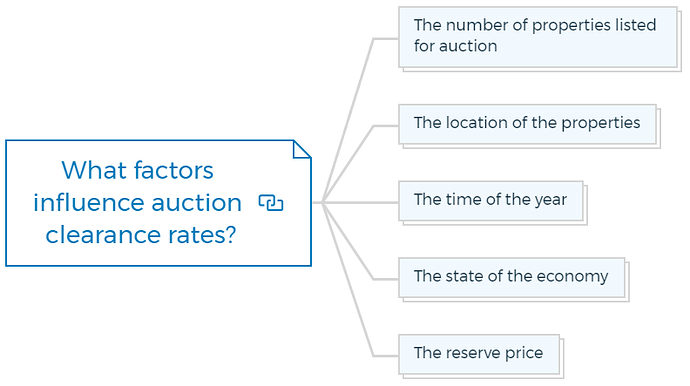What does auction clearance rate mean?
Auction clearance rates are an essential metric in the property development industry that is closely watched by buyers, sellers, and industry professionals alike. A commonly used term indicates the percentage of auctioned properties sold in an auction. The percentile ratio is derived by implying the method proposed by REIV.
What is the Auction Clearance Rate (ACR)?
Auction clearance rates are the percentage of properties sold. It measures property market demand by dividing the number of auction sales by the number of auctions.
The auction clearance rate is 70% if 100 properties are auctioned and out of which 70 are sold.
Quick Tip
Auction Clearance Rate Definition
The auction clearance rate is the percentage of properties sold at auction compared to the total number offered.
This method calculates the clearance rate by adding the number of sold properties before, after, and during the auction.
Why are auction clearance rates important?
Auction clearance rates indicate property market health. High clearance rates imply strong demand and a competitive market, whereas low clearance rates reflect buyer disinterest.
A high auction clearing rate indicates strong buyer demand and a good price for sellers. However, a poor clearance rate may suggest they change their expectations and price strategy.
Buyers should act fast and make competitive bids if the auction clearance rate is high, while a low rate may indicate less competition and more negotiation options.
ACR can come in handy when buying a property in a suburban area. For instance, you need to have an aerial view of the whole situation before stepping into any significant processes. When you look at things from a broader perspective, you get a clear picture of everything unfolding in your surroundings from the top.
Hence, you can consider all the factors that could affect your decision. ACR is one of the tools that help you conclude viable reports and statistics.
For example, the general mean ratio of the property sold under the hammer in real time of auction is around 48%, and the rest is taken care of in the post-auction ritual.
This helps us compare whether the ratio of the auction is more than 75%, the demand is high, and vice versa if it’s below 50%. This conclusion leaves us with a friendly tip for avoiding any purchases made in a rush.
Hence, keep an eye on your desired short-listed suburbs.
You are missing out if you haven’t yet subscribed to our YouTube channel.
How to calculate auction clearance rates (ACR)?
The auction clearance rate is computed by dividing the number of properties sold at auction by the total number offered. The clearance percentage is 80% if 80 of 100 auctioned properties are sold.
The number of properties placed for auction, their location, the time of year, and the economy can all affect the auction clearance rate.
ACR can be affected by external factors, including the weekend’s clearance rate, sporting events, religious holidays and weather. But to be precise about your decision and its outcomes, you should incorporate some other factors in your feasibility report before buying or selling.
Lastly, if you are keen to compare and observe the market, attending a local auction before buying or selling a property provides you with an overview.
You can use the site I mentioned in the video to know the ACR by suburbs. It gives you the year-to-date Melbourne-wide clearance rate. You will quickly have the perfect snapshots of what suburbs are doing well and what are not.
Check out the video, and you will see how to understand the clearance rate map and how to use that information in your property development and investment decisions.
What factors influence auction clearance rates?
Auction clearance rates are affected by the following:
The number of properties listed for auction
Due to seller rivalry, a high number of auctioned properties might affect clearance rates.
The location of the properties
Auction clearance rates can vary by location, with some areas having higher demand than others.
The time of the year
Auction clearance rates tend to be higher in spring, as this is traditionally a popular time for buying and selling property.
The state of the economy
Strong economies boost auction clearance rates because buyers are more confident in the market and more likely to buy.
Learn More
The reserve price
If the reserve price is set too high, it can deter buyers and lead to a lower clearance rate.
How are auction clearance rates reported?
Real estate agents, industry associations, and media outlets typically report auction clearance rates. The Real Estate Institute of Australia (REIA) publishes auction clearance rates weekly.
Auction clearing rates vary by location and property type. Clearance rates for houses and apartments may range. To gain a better market picture, look at clearance rates over time, not just one week or auctions.
What are the benefits of tracking auction clearance rates?
Auction clearing rates give buyers, sellers, and real estate professionals crucial market knowledge. Tracking auction clearing rates has advantages:
For Buyers: Auction clearance rates can indicate how competitive property bidding will be.
For Sellers: High clearing rates suggest strong demand for property in a particular location, which may result in a higher sale price.
For real estate professionals: Auction clearance rates can help agents decide whether to auction or privately sell a property.
Learn More
Auction clearance rates can inform buyers, sellers, and real estate professionals about the property market’s health. Tracking clearance rates might help you make informed property purchases or sales.
Test Your Knowledge
Understanding Auction Clearance Rates: A Practical Assignment
Objective
This assignment aims to deepen your understanding of auction clearance rates (ACR) and their significance in the property market. By completing this exercise, you will learn how to calculate ACR, interpret its implications for buyers, sellers, and the broader market, and apply this knowledge in a real-world context.
Part 1: Calculation and Interpretation
To Do:
- Calculate ACR: Given a dataset of 150 properties listed for auction, where 90 were sold, calculate the auction clearance rate. Show your working.
- Interpretation: Explain what an ACR of 60% versus an ACR of 80% indicates about market demand and seller expectations.
Questions:
- What does a high auction clearance rate indicate about buyer demand and market competition?
- How might a low auction clearance rate affect a seller’s pricing strategy?
Part 2: Research and Application
To Do:
- Research ACR in Your Area: Choose a suburb or region. Research its latest auction clearance rates using a real estate website or a database mentioned in relevant tutorials or articles. Note the ACR and any factors that might be influencing it (e.g., time of year, economic conditions).
- Case Study Analysis: Based on the ACR you found, analyse whether it’s a good time to buy or sell property in your chosen area. Consider other influencing factors mentioned in your research.
Questions:
- How do external factors like sporting events, holidays, and weather affect auction clearance rates?
- Discuss the importance of location and time of year on ACR. Provide examples to support your arguments.
Part 3: Critical Thinking
To Do:
- Predicting Future Trends: Based on current ACR trends and external factors you’ve identified, predict the short-term future of the property market in your chosen area. Consider potential changes in the economy, interest rates, and housing demand.
- Create a Strategy: Develop a strategy for a buyer or seller based on your predictions. Outline steps they should take to maximize their outcomes in the current market.
Questions:
- What role does the reserve price play in determining the auction clearance rate?
- How can real estate professionals use ACR data to advise their clients on whether to auction or sell privately?
Part 4: Presentation
To Do:
Prepare a Presentation: Compile your findings, analyses, and strategies into a presentation.
Include:
- Introduction to Auction Clearance Rates and their importance.
- Your calculations, research findings, and case study analysis.
- Predictions for the property market in your chosen area.
- Strategies for buyers or sellers.
- Conclusion summarising the key takeaways.
Format: The presentation can be in the form of slides, a report, or a video. Ensure it’s structured logically, with clear explanations and supporting evidence for your analyses and recommendations.
Submission Guidelines:
- Submit your presentation in the required format.
- Ensure your work is original, and cite any sources you use for data or research.







